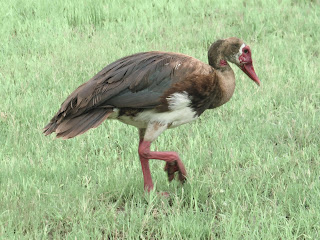Here are photos are from the Okavango Delta in Botswana, where we stayed at Machaba Camp, our favorite of all the safari camps and lodges we visited during our four weeks of safaris. We were there Feb. 3 to 6, which is in the rainy season, so a lot of the understory plants were green and leafy, giving animals better cover and making them harder to see. Oddly, the dry season later in the year is when the Okavango floods because that's when the water from the rainy season in Angola reaches the Kalahari. The Okavango is part of the Kalahari, the world's largest expanse of a single type of sand. All that flood water eventually disappears into the sand. For more about our African trip, keep scrolling and hitting "older posts" or simply click
HERE.
 |
One of the nicest things about Machaba Camp is that all drinks are included, so guests are free
to make themselves cocktails anytime. Few, however, take advantage of this. Getting up at 5 a.m.
every day means you don't want to over-imbibe in the evening. This is half of the main tent; the
other half is a dining area. |
 |
| Knob-billed duck. |
 |
| Sacred ibis. |
 |
| African jacana. |
 |
Hippos could often be spotted in the Khwai River
beside Machaba Camp. |
 |
| Wattled crane. |
 |
| Female antelope and their young. |
 |
| Bearded woodpecker. |
 |
| Baboons formed a line and took turns jumping over a stream near Machaba Camp. |
 |
| Female impala. |
 |
A male elephant amid the damage done to woodlands by elephants. They strip trees of bark
and they knock over trees. The fallen trees, however, are quickly put to use by a
variety of insects and provide cover for small animals. |
 |
| The peaceable kingdom. Zebra and giraffes in the Okavango Delta. |
 |
Notice the tan stripes between the zebras' black stripes. These "shadow stripes" are rarely seen
among zebras in Tanzania. We were told that it's a normal genetic variation. |
 |
| Female kudu. |
 |
| Steenbok, one of the smallest antelope. |
 |
| A female impala and her calf. |
 |
| Warthogs. |
 |
| A waterbok or waterbuck, one of Africa's many majestic antelope. |
 |
On one morning's game drive, the camp staff had breakfast waiting for us in the bush. The
woman was camp guest who had skipped the game drive but caught a ride with
staff to meet her husband and everyone else for breakfast. |
 |
Cormorants in Africa have to dry their
wings just like cormorants in the Americas. |
 |
| Our guide, Shaun Malan, spotted this lizard in a tree while driving past. It's a flap-necked chameleon. |
 |
Instead of a game drive one morning, we had a mokoro safari,
with a guide poling our little boat (fiberglass, not wood) along
a stream that's seldom visited by hippos. |
 |
Our guide spotted this little frog
from 30 or 40 feet away. It's
about the size of my little finger. |
 |
| The Okavango Delta offers one dreamscape after another. |
 |
| Black and white kingfisher. |
 |
| Impalas. |
 |
| Tsessebe, yet another antelope. |
 |
| The tsessebe is the fastest antelope in Africa. |
 |
This beautiful leopard is known as the Machaba female because the camp is within
her territory. She hadn't been seen for several weeks before this
nighttime sighting. Our guide shone a spotlight on her, allowing
me to get this photo without a flash. |
 |
We saw the Machaba female again the next morning, this time
with her year-old male cub. One of the advantage of using guides
based at the safari camp is that they often know the life stories
of some of the animals. |
 |
| African wild dog. |
 |
A dwarf mongoose looks out from its home in an abandoned
termite mound. We also saw banded mongoose here,
but they were on the move and I didn't get a good photo. |
 |
| Female waterbok. |
 |
| A fish eagle about to take off. |


























































thank you for sharing best information with us i reffered this to my friends And i am providing tourism African Safaris
ReplyDelete